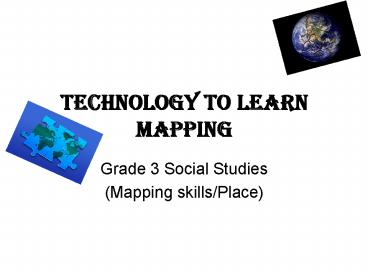Technology To Learn Mapping - PowerPoint PPT Presentation
1 / 22
Title: Technology To Learn Mapping
1
Technology To Learn Mapping
- Grade 3 Social Studies
- (Mapping skills/Place)
2
Why are you choosing this aspect of the
curriculum to focus on?
- New to the grade (when I started the BluePrint)
3
- Very few materials available (now I have
Materials)
4
- The unit offers cross curricular experiences
5
- Student engagement
6
- Allows me to meet the needs of all learners
- (Differentiated instruction)
- Carol Ann Tomlinson Differentiation of
Instruction in the Elementary Grades
7
- The class doesnt respond well to a lecture
approach. - I am using a series of mini lessons based on the
three part lesson model. - introduction, exploration and conclusion/sharing
time
8
Materials
- Some of the things I will be using are computers,
maps, atlases, Google Earth, Globes, etc. The
complete list of materials can be found on the
website.. - http//hrsbstaff.ednet.ns.ca/dkeddy/materials.htm
9
How will technology support learners
- It will give them a choice of ways to share what
they have learned (PowerPoint, Wordle, Toondoo,
Comic Life, etc.). - It will allow me to engage students in solving
problems, making decisions and exploring
intriguing questions. - (Marc Prensky, Engage Me Or Enrage Me.)
10
- It allows students to explore, research, invent,
play and create. (Ken Robinson) (Stuart Brown)
11
- It will allow me to use Differentiating
instruction, (creating multiple paths so that
students of different abilities, interest or
learning needs experience equally appropriate
ways to absorb, use, develop and present concepts
as a part of the daily learning process). (Carol
Ann Tomlinson)
12
How I will connect to all learners
- The unit is designed to work with learners of all
levels. (IPP, Adaptations)
13
- Less pencil/paper work and more hands on.
(exploring the concept to learn).
14
- Lessons will be delivered in a variety of ways
PowerPoint, videos, students exploring websites,
etc.
15
How will you show evidence of student success?
- Direct Evidence students show their mastery of
learning goals through the demonstration of
knowledge, skills, etc. - Indirect Evidence general perception or
comparison data that allows you to make
inferences about learning, but does not
demonstrate actual learning.
16
Direct Evidence
- The students will be able to use Google Earth and
Google maps independently. - They will show greater knowledge of basic map
skills and how a compass rose works. - They will show a greater understanding of the
unit being taught. - They will be able to locate their province in the
Atlantic Region, Canada, North America and the
World.
17
Indirect Evidence
- Student Surveys
- Class Grades for this subject area
- They will be more engaged in the lessons.
18
Content to be covered
- Handouts
- Online Video
- PowerPoints
- Google Earth (downloaded on all lab computers)
- Toondoo (www.toondoo.com)
- Google Maps http//maps.google.ca/maps?hlentabw
l - The online compass and mapping symbols game found
here http//www.sfsocialstudies.com/g1/u2/index.ht
ml and - http//www.mywonderfulworld.org/toolsforadventure/
games/adventure.html - Neighborhood Map Machine 2.0 (software on
classroom laptop) for group lessons about compass
directions, reading maps and creating maps. - GPS units (how to use and a treasure hunt
activity). - The book Follow That Map, by Scot Ritchie.
19
Assessment materials
- Class checklists
- Rubrics
- I will give them their choice of using Toondoo,
PowerPoint or Word to make short stories or
reports about what they have learned in this
unit. - My struggling learners (IPP and Adaptations) can
create this report by doing a video or audio
recording of themselves talking about what they
have learned. - Student interviews
- Journals
20
Outcomes
- TTLM covers social studies, math, language arts
and ICT outcomes. - http//hrsbstaff.ednet.ns.ca/dkeddy/outcome.htm
21
The Lessons
- They will be taught using a 3 part lesson format
(introduction, exploration and conclusion/sharing)
- Designed to be simple to follow and use.
- Student exemplars are included with those that
need it. - Links to rubrics included.
- http//hrsbstaff.ednet.ns.ca/dkeddy/lesson.htm
22
Thats All Folks































